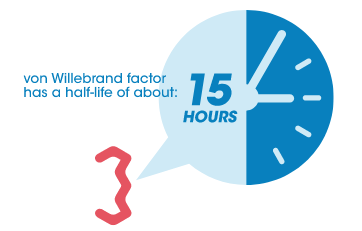Get a 2-page visual summary of the clotting cascade
HOW CLOTTING WORKS
Understanding how a clot is formed is no easy task! So let’s break it down step by step. When an injury causes a bleed, a process called hemostasis occurs at the injury site to form a clot and stop the bleed.
In hemostasis, a delicate balance between procoagulants and anticoagulants unfolds.
Procoagulants
Procoagulants (e.g., factor VIII, factor IX, von Willebrand factor, and thrombin) promote blood clotting.
Anticoagulants
Anticoagulants (e.g., antithrombin) reduce clotting activity to maintain normal blood flow and prevent unwanted clotting.
When an injury occurs, primary hemostasis and secondary hemostasis occur together to reduce blood loss and to form a stable clot.

This is where platelets are recruited to the site of the injury by exposed molecules of the vessel wall (such as collagen and von Willebrand factor) to form a “platelet plug” to reduce blood loss.

This is where a multi-step process called the “clotting cascade” is activated to stabilize the clot.
THE CLOTTING CASCADE

After an injury occurs, platelets start forming a clot, but they need help sticking together to
fully stop the bleeding, which is where the clotting cascade comes in.

The clotting cascade is a dynamic natural process involving a series of proteins. These proteins help form a mesh around the unstable platelet plug to form a stable clot.
The goal of the clotting cascade is to achieve hemostasis. When someone has hemophilia, the lack of factor VIII or factor IX prevents clot formation by reducing the ability for thrombin generation, without which hemostasis is thrown off balance and stable clots cannot form.

Once the clotting cascade is underway, factor VIII (missing or deficient in hemophilia A) becomes activated factor VIII and then works together with activated factor IX to activate factor X.

After factors VIII, IX, and X are activated, they work together to generate thrombin, which is necessary to form a stable clot.

Then thrombin converts fibrinogen into fibrin, which is what creates the fibrin mesh that spreads over the platelets and helps them bond together into the stable clot that stops the bleeding.
FOR HEMOSTASIS TO WORK:
All factors need to be present.
When just one factor is missing or not working, such as factor VIII in hemophilia A or factor IX in hemophilia B, hemostasis cannot be achieved.
Get a 2-page visual summary of the clotting cascade
VON WILLEBRAND FACTOR & HEMOPHILIA A

Factor VIII is a protein (clotting factor) found in our blood. During the clotting cascade, activated factor VIII helps to generate thrombin, which is necessary to form a stable clot. But how long factor VIII lasts in the body has to do with one other protein, called von Willebrand factor (vWF).

Like bosom buddies traveling side by side, vWF binds with factor VIII and protects it from being broken down as long as they are bound together. It carries factor VIII until it is activated by thrombin at the site of an injury, and is released from vWF.

However, vWF has a half-life of only about 15 hours, so when it is cleared from the blood, factor VIII gets removed as well. Thus, vWF binding limits the half-life of natural factor VIII and factor VIII replacement therapies alike.
HEMOPHILIA B & FACTOR lX
In hemophilia B, it’s factor IX that is missing or not working properly, thus preventing the blood from clotting properly and controlling bleeding.

But unlike factor VIII, which stays in the blood, factor IX travels in and out of the bloodstream into the extravascular space (where it binds to a protein called type IV collagen). During clotting, factor IX works with factor VIII to generate thrombin, which is necessary to form a stable clot.
Because factor IX can leave the bloodstream, its levels in the blood (trough levels) may not accurately indicate the total amount of factor IX activity and how well a factor IX therapy can protect you from bleeds.
Learn more about living with hemophilia B

Talk to your doctor to learn more about your hemophilia treatment options.
Treatments and treatment regimens for hemophilia work in different ways to provide protection from bleeds and restore hemostasis when an injury occurs.
CONTINUE ON TO GET FACTOR FLUENT
GET COMMUNITY EDUCATION
If you’re looking for more info or resources, our dedicated team of Community Relations & Education (CoRe) managers is ready to connect one-on-one, anytime. They’re just a call or email away.
STAY INFORMED
Sign up to receive helpful information to address your hemophilia needs, such as disease education, treatment options, and other resources to help you make the best decisions for your goals.
MAT-US-2204624-v2.0-11/2022